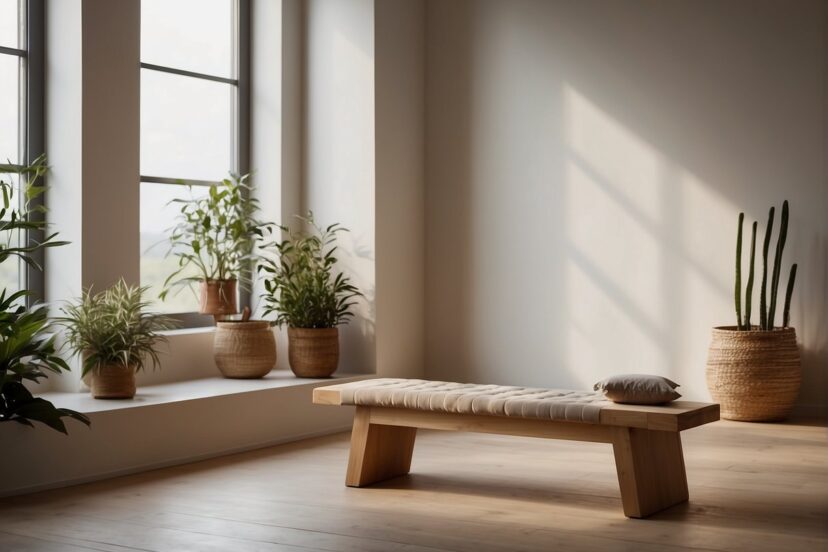Meditation Bench Essentials: Choosing the Right One
*We may earn a commission for purchases made using our links. Please see our disclosure to learn more.
Meditation Bench Essentials: Choosing the Right One for Your Practice
Meditation has increasingly become a part of many people’s lives as they seek to reduce stress, improve concentration, and enhance overall well-being. Among the various tools and accessories that can support the practice, a meditation bench has proven to be an invaluable asset. As someone who has explored the nuances of various meditation practices, I’ve found that comfort and posture play critical roles in sustaining a meditative state. A meditation bench facilitates this by providing the necessary support to maintain proper alignment of the spine, thus allowing for a more focused and prolonged meditation experience.

Crafted from a variety of materials such as sustainable wood, bamboo, or even cushioned fabrics, meditation benches come in different styles to cater to the diverse preferences of practitioners. I have noticed the ergonomic design of these benches is functional and aesthetically pleasing, blending effortlessly into the tranquil ambiance of a meditation space. Whether portable or stationary, the design often considers the intricacies of body mechanics, promoting ease in the knees, ankles, and hips, which can be especially beneficial for those with limited flexibility.
Over the years, I’ve seen meditation benches evolve to become more user-friendly, with features such as folding legs and height adjustability. This adaptability not only accommodates a range of body types but also supports various meditation postures such as Seiza or cross-legged positions. The incorporation of padded cushions and support systems further enhances the comfort level, enabling individuals to transition smoothly into deeper states of meditation without unnecessary physical distraction.
Types of Meditation Benches

In selecting the perfect meditation bench, understanding the various types available is crucial for finding one that suits individual preferences and enhances the meditation experience.
Traditional Meditation Benches
Traditional meditation benches, often referred to as Seiza benches, are designed for the Seiza sitting position. These benches are usually fixed in height and made of solid materials like birch wood or bamboo. The simplicity of a traditional bench, such as the widely appreciated Spoko Meditation Bench, supports a stable and grounded practice.
Adjustable Meditation Benches
For those who require flexibility, adjustable meditation benches offer the ability to change the seat height or tilt to accommodate various body types and seating preferences. This adjustability is typically achieved through the use of hinges or removable pieces. Materials like sturdy plywood or steel mechanisms are common in these benches, ensuring both longevity and comfort.
Portable and Foldable Benches
Portable and foldable benches cater to meditators on the move. The Nomad Meditation Bench, crafted by Still Sitting, exemplifies convenience without compromising stability. These benches often employ a folding mechanism that makes them easy to pack and carry, and they are popular among those who attend meditation retreats or practice outdoors.
Ergonomic Meditation Benches
Ergonomic meditation benches are designed to promote proper posture and reduce strain during prolonged meditation sessions. The Lotuscrafts Meditation Bench is known for its ergonomic shape, which can both enhance comfort and support the natural curvature of the spine. These benches are crafted with the meditator’s body in mind, featuring contours that encourage a relaxed yet alert meditative state.
Benefits of Using a Meditation Bench

When I use a meditation bench, I notice a marked improvement in my meditation practice. Here are some specific benefits I experience:
Improves Posture
A meditation bench encourages proper posture by supporting the body’s natural alignment. The design of the bench assists in tilting the pelvis slightly forward, which helps align the spine. This alignment allows me to maintain a good posture without straining, ensuring the spine stays aligned and reducing the risk of discomfort.
Enhances Comfort
Comfort is paramount in meditation, and using a meditation bench enhances this aspect significantly. The stable platform of the bench relieves pressure from my legs and feet during a kneeling position. This stability helps to prevent numbness and maintains circulation, allowing me to focus on meditating rather than any physical distractions.
Supports Longer Meditation Sessions
Since the bench alleviates discomfort by promoting correct posture and enhanced comfort, it enables me to meditate for longer periods. The reduction in physical strain allows my body to settle into the practice without the distraction of pain or the need to frequently adjust my position. This support translates into deeper and more fulfilling meditation sessions.
Choosing the Right Meditation Bench

When selecting a meditation bench, I consider materials, size, durability, and the type of support it offers to ensure comfort and portability for my practice.
Materials and Durability
I prioritize benches made from durable hardwoods like bamboo or maple, which offer longevity. Eco-friendly options can include sustainable woods or 100% recycled materials. My bench should withstand regular use, making durability as essential as the materials’ eco-friendly nature.
- Common Materials: Bamboo, Maple, Cherry
- Eco-Friendly Picks: Reclaimed Wood, Sustainable Sources
- Durability Indicators: Solid Construction, Quality Finishing, Warranty
Size and Portability
I look for a bench that is lightweight and portable, especially if I plan to carry it to a group session or travel with it. Foldable legs are a feature that can improve transportability. The size should accommodate my frame and be adjustable or available in different heights to allow for a comfortable seiza or cross-legged position.
- Portable Features: Foldable Legs, Light Build
- Size Variations: Adjustable Height, Multiple Width Options
- Travel-Friendly: Travel bags, often made of organic cotton or other durable fabrics
Cushioning and Support
The ergonomic design of the bench is crucial for aligning my spine and promoting comfort. Benches may come with or without cushioning; sometimes, additional meditation cushions or zafu pillows may be required. Cushions should ideally be filled with materials like wool or be a wool-filled zabuton.
- Cushioning: Memory Foam, Wool, Kapok
- Support Types: Ergonomic Design, Curved Seats, Backrests
- Fabrics: Breathable Covers, Removable and Washable Options
By focusing on these specifics, I’m able to find a meditation bench that is sustainable, convenient for travel, and supportive for my practice.
Setting Up Your Meditation Space

Setting up a meditation space is essential for establishing a serene environment conducive to effective meditation practice. Both location and accessories play a pivotal role in shaping this tranquil area.
Selecting the Appropriate Location
Finding the right spot is crucial for a meditation space. It needs to be a quiet area where disturbance is minimal. I recommend allocating a space that isn’t used for active daily tasks to maintain a clear association with relaxation. Consider spaces with ample natural light if possible. The environment should promote focus and comfort, being neither too cramped nor too open, so as not to feel lost in the space.
For those who practice sitting meditation, such as in the lotus or cross-legged position, ensuring that the knees are comfortable is imperative. A flat and stable surface can support maintaining a proper posture without unnecessary pressure on the knees.
Meditation Accessories
The right accessories can enhance meditation practice. Here’s a concise list of items to consider:
- Cushions and Mats: A padded fabric seat such as a zabuton mat is ideal for cushioning pressure points. A meditation cushion or bolster pillow helps with aligning the spine correctly, which is vital for extended meditation sessions.
- Meditation Benches: These are designed to keep the spine straight while minimizing stress on the knees. An adjustable meditation bench caters to different heights and flexibility levels.
- Inspiration and Focus: Items like Buddhist statues or inspirational home decor can serve as focal points or offer visual peace. An altar table might be used to place items that have spiritual significance to your practice.
By thoughtfully setting up your meditation space with consideration for both location and accessories, a foundation is laid for a rewarding and consistent meditation practice.
Care and Maintenance of a Meditation Bench

When I focus on the maintenance of my meditation bench, I ensure its durability and contribute to its longevity. I regularly clean the bench, starting with dusting and then wiping it with a damp cloth. For a meditation bench with a fabric seat, I’m cautious to use fabric cleaners that are appropriate for the material. It prevents stains and keeps the fabric in pristine condition.
For any cushions associated with the bench, vacuuming them occasionally removes dust and potential allergens. I also check the care labels to see if they are machine washable or if they require special cleaning instructions.
Here are some quick tips I follow for bench maintenance:
- Regular Inspection: I periodically inspect my bench for any wear and tear, especially the legs and joints, to catch issues early.
- Proper Storage: When not in use, I store my bench in a dry place to prevent moisture damage or warping.
- Avoid Harsh Chemicals: I use mild cleaning solutions to prevent damage to both the wood and any fabric components.
Sticking to these maintenance routines keeps my meditation bench supportive and comfortable, making my meditation practice a peaceful retreat.
Making a Purchase
When I decide to buy a meditation bench, I focus on finding a reliable source and understanding the nuances of online shopping to ensure I get the best value for my money.
Where to Buy a Meditation Bench
I usually start my search in stores or online platforms that specialize in meditation supplies. It’s important to me to have a range of options, from affordable models to more handcrafted meditation benches. For those who prioritize portability, the Nomad Meditation Bench is a popular choice among practitioners for its transportable design. I also look for stores that carry complementary items like buckwheat zafu pillows and bolster pillows to enhance my meditation experience.
- Physical Stores: You can physically inspect the benches, and store staff can offer personalized advice.
- Online Stores: Greater variety and often more competitive prices. Look for well-reviewed products such as the Still Sitting Meditation Bench.
Considerations for Online Shopping
Before making an online purchase, I scrutinize product reviews to guide my choice. Reviews can give me insight into aspects like durability and comfort that are hard to gauge from photos.
I also check the return policy of the products, as it’s crucial to have the option to return an item if it doesn’t meet my expectations. Furthermore, when clicking affiliate links, I’m aware that the recommender may receive a commission, but that doesn’t deter me if the product is right for me.
Payment Method: I prefer secure payment methods. Shipping: I check if the cost is reasonable and the packaging is adequate to protect the bench in transit.
Frequently Asked Questions
When selecting a meditation bench, it’s important to consider your personal needs and how the bench will enhance your practice. Below are some common questions you might have while choosing the best bench for your meditation sessions.
1. How do I choose the right meditation bench for my practice?
I look for a bench that fits my body size and flexibility. The bench height should allow my knees to rest comfortably on the ground without causing strain. I also check for a sturdy construction that supports my weight while sitting.
2. What are the benefits of using a seiza bench during meditation?
Using a seiza bench helps me maintain proper spine alignment and reduces stress on my knees and ankles. This position can lead to a more comfortable and longer meditation practice by minimizing physical discomfort.
3. Are there specific meditation bench designs for people with bad knees?
Yes, there are meditation bench designs that take into account those with knee issues. I seek out benches with padded seats or the option to add a cushion for extra support. Some benches have adjustable heights which can reduce the angle and pressure on the knees.
4. What should I consider when looking for a folding meditation bench?
For a folding meditation bench, I look for one that has reliable hinges and stays secure when in use. Portability and ease of storage are also factors I consider, as well as the durability of the materials used to ensure it withstands regular folding and unfolding.
5. How does a meditation bench compare to using a cushion?
A meditation bench provides a stable seat which can be beneficial for my posture, whereas a cushion might offer more flexibility in seating position. I find that benches can be more supportive than cushions, which is helpful for longer meditation sessions.




